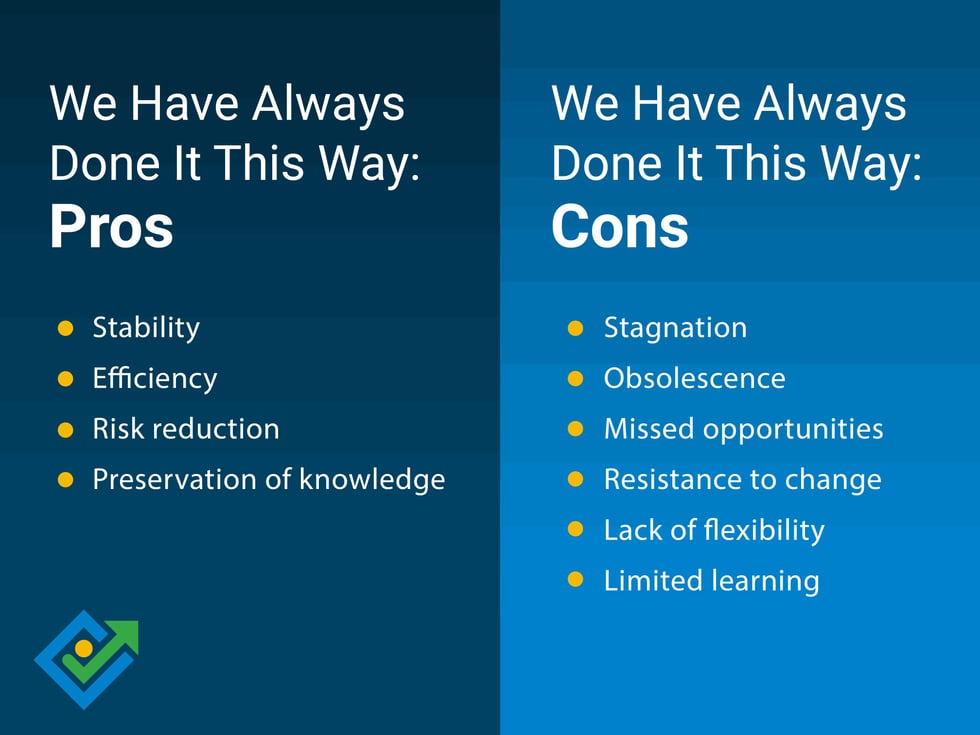
The most dangerous phrase in the language: "We have always done it this way!"
These words, attributed to Rear Admiral and computer scientist Grace Hopper, offer real insight into patterns that keep businesses stuck. We live in changing times. Business, people, regulations, communications, and more. Your suppliers innovate and offer new products or new technology. Remember how the pandemic affected your entire organization? Change is inevitable.
Because your operating policies and procedures make processes visible, that can be a useful tool in evaluating if your current processes still make sense. You can also work to ensure everyone has a common understanding of how things are done. You might be astounded to hear how often someone says, “I didn’t know we did it that way.”
There is no need to change for the sake of change, but is there a better way of doing things? Or is the way we have always done it still working for us? Hard work with the wrong process is a real threat to productivity and low morale.
Example: Is your current policy and procedure management working?
Are your SOPs and policies and procedures in a binder on a shelf gathering dust? Are they buried in Word documents in SharePoint, gathering virtual dust? If the answer is yes, or your processes aren’t captured, or employees aren’t using them, it’s probably time to abandon “We’ve always done it this way.”
We Have Always Done It This Way: Pros and Cons

Pros of “We have always done it this way.”
There are advantages to keeping the status quo.
For example, if your employees are using your policies and procedure and getting benefits, that’s a good thing! You’re getting benefits from current practices, honed over time from trial and error. Keep up the good work!
Stability: Following an established approach provides a sense of stability and familiarity. It can be comforting for employees and managers to rely on methods that have proven successful in the past. If it’s not broken, don’t fix it, as they say.
Efficiency: Established processes and procedures are often efficient because they have been refined over time. You can save time and effort in the present by relying on past tests and experimentation.
Risk reduction: Sticking to what has been done before can reduce the likelihood of making mistakes or encountering unexpected problems. It provides a known baseline and minimizes the potential for errors.
Preservation of knowledge: Traditional methods often carry valuable institutional or “tribal” knowledge and expertise. By continuing established practices, organizations can retain and pass on accumulated wisdom.
Cons of “We have always done it this way.”
The worst part of resisting change can affect your bottom line and the continuity of your business. It’s up to leaders, decision-makers, and individuals to assess the key reasons to change and avoid these cons.
Stagnation: Relying solely on past methods can hinder innovation and growth. It discourages the exploration of new ideas, technologies, and approaches that may lead to better outcomes. High-performing employees may grow bored or disengaged in a stagnated environment.
Obsolescence: The world is constantly changing, and what worked in the past may not be effective in a new context. The "we've always done it this way" mindset may prevent organizations from adapting to evolving circumstances. Think Blockbuster.
Missed opportunities: By rejecting alternative approaches and ideas, organizations may miss out on potential improvements or advancements that could enhance innovation, productivity, or competitiveness. Relying on past success is not the best strategy for moving forward. The demise of Blockbuster was probably the missed opportunity to buy Netflix.
Resistance to change: The "we've always done it this way" mentality can affect the work culture and create resistance to change within an organization. It may discourage employees from suggesting new ideas or challenging existing practices, stifling creativity and innovation.
Lack of flexibility: Blindly adhering to established processes can limit adaptability and agility. It may prevent organizations or departments from responding effectively to changes in the market, customer preferences, or emerging trends.
Limited learning: Exploring new methods and approaches often involves learning that can lead to valuable insights and knowledge. Organizations may miss out on valuable learning opportunities around software, leadership styles, communication channels, and more by sticking to the status quo.
The takeaway
The takeaway here is not to solve problems that you don’t have, but rather that you should consider the possibility that what once worked, no longer does. There are valid reasons to change the way you do things, find a new approach to solving a problem, and generate new ideas.
A streamlined business is one that is constantly assessing itself and ensuring its operations are under control. Your operating SOPs and policies should reflect those best practices.
Some of those SOPs may fall into the category of “we’ve always done it this way,” and some processes may be new and improved.
The larger takeaway here is to make sure your policy and procedure system is effective and easy to change so that it truly reflects how your organization works. Zavanta software is engineered for change, automating the complete policy and procedure life cycle. Its structured content model makes it easier to author, review, manage, update, translate, publish, monitor, and use policies and SOPs.
Contact us today to start a conversation.
Additional Resources

